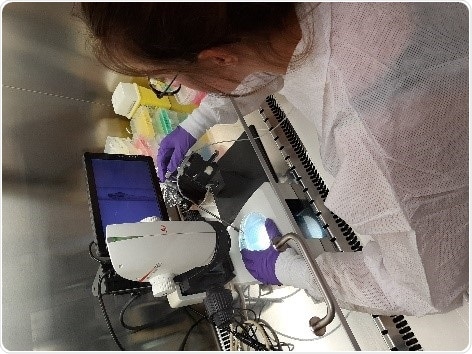Zebrafish larvae can serve as a robust replication model of human noroviruses, according to a study published September 19 in the open-access journal PLOS Pathogens by Joana Rocha-Pereira, Peter de Witte and Johan Neyts, of KU Leuven in Belgium, and colleagues. As noted by the authors, this model is a major step forward in the study of human norovirus replication and is the first robust small laboratory animal model of human norovirus infection.

Injection of zebrafish larvae with human norovirus. Credit: Jana Van Dycke
Human noroviruses are the most common cause of foodborne illness, with a societal cost of $60 billion and 219,000 deaths each year. The lack of robust small animal models has significantly hindered the understanding of norovirus biology and the development of effective therapeutics.
In the new study, researchers report that human noroviruses replicate to high concentrations in zebrafish (Danio rerio) larvae. Replication peaks on the second day after infection and is detectable for at least six days. Human noroviruses are detected in hematopoietic cells and the intestine. Moreover, antiviral treatment reduces human norovirus replication, showing that this model is suited for antiviral studies. According to the authors, zebrafish larvae constitute a simple and robust replication model that will largely facilitate studies of human norovirus biology and the development of antiviral strategies.
Rocha- Pereira adds:
We will now be able to visualize the interactions of human norovirus with the host in real time using transparent zebrafish and in this way answer questions that have long been asked regarding norovirus biology.”
Source:
Journal reference:
Van Dycke, J. et al. (2019) A robust human norovirus replication model in zebrafish larvae. PLOS Pathogens. doi.org/10.1371/journal.ppat.1008009.